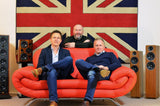Opera Loudspeakers Seconda SE
Opera Loudspeakers

The Company

Opera Loudspeakers was founded in 1989, but its origins go back to the early 1980s, to an unusual but highly fruitful synergy between two cultures and two audiophiles, one Italian and the other English. The first loudspeaker to bear the Opera name was called Caruso, and was the precursor of a series named in homage to the legendary voices of the lyric opera. Callas, Operetta and Divina soon followed, each gaining enthusiastic acclaim in the developed audio markets of the world. Opera loudspeakers immediately appeared as a fusion between the old and the new: between traditional Italian craftsmanship in cabinet-making and the most advanced acoustic technology. Every Opera loudspeaker, even the least expensive model, follows a tried and tested philosophy of design: the use of top quality materials allied to carefully applied basic principles of acoustic science. Today our loudspeakers are exported everywhere, from Europe to the Far East with relevant space on the most important hi-fi magazines.
Our intent is to create a complete line of high quality , beautiful to see and to listen to; we then developed over therefore also a line of accessories with the same principle that gave prestige to our speakers.
Gianni Maria Sacchetti, founder
Opera Seconda SE Loudspeaker
Opera Loudspeakers is one of the few manufacturers that uses the closed box to load the woofer. The new Opera Seconda, after the success of its predecessors, is a two-and-a-half-way floorstanding system that still uses a sealed box, but it has been completely updated. The cabinet structure, drivers and crossovers are totally new.
Drivers
The new 7” woofer is a custom design made by Scanspeak for the entirely new Classica series. This woofer has excellent performance in the mid-frequencies; so much so that it is used as a midrange in the Quinta model. It is equipped with an aluminum diaphragm, a 38 mm coil (two-layer, CCWA wire) with aluminum former immersed in a suitably shaped air gap. There is also a metal ring around the pole piece to control the flux variations. The basket is die-cast for maximum stiffness. Compared to its predecessor, the volume displacement is increased by a very significant 10%. The rigid aluminum diaphragm is free from sub-harmonics from transverse modes and perfectly reproduces the lower frequencies. The two woofers, connected in parallel, share the same 40 liter enclosed volume.
The tweeter, a D26 series model made by Scanspeak, has a one inch high quality treated soft dome, double magnet, decompression chamber, ferrofluid, aluminum flange and a one mm. peak to peak linear excursion (twice as much as a conventional tweeter). The frequency response extends to 30kHz (0 dB) and 40 kHz is reproduced (-6 dB). The resonant frequency is about 860 Hz which makes this tweeter insensitive to vibrations from other loudspeakers (due to the heavy 30 mm MDF used on the front panel).
Crossover
The crossover circuit of this two-and-a-half-way design is divided into two different boards placed at a suitable distance from each other to reduce the effects of the mutual inductance of the coils. The tweeter high-pass section is designed to minimize the microphonic effect (something that is rarely done in other designs).
The capacitors used in the signal path have been carefully selected. This also contributes to the stability of the virtual central channel to create a stable and precise soundstage.
Cabinet
The cabinet follows the curvature of the upper section of our flagship Malibran model. The front panel, made from 30 mm thick MDF, is wide enough to accommodate the loudspeaker drivers, and has rounded edges that are covered in leather which also acts as a seal for the speaker enclosure. The sides of the cabinet are veneered with real wood and finely polished. The structure is further stiffened by internal bracing. Inside the cabinet there is two layers of pyramidal shaped, 10 cm thick, polyurethane which absorbs the rear radiation of the woofers. As a consequence, consistency and clarity are the hallmarks of the sound of this speaker. The Opera Seconda is also equipped with strong iron bars for wheels or spikes.
The four external connectors (the Seconda is designed for bi-wiring) are traditional gold-plated brass connectors, which is the same for all Opera speakers including our top models. They accept any kind of termination, providing a safe and effective electrical and mechanical contact.
The insensitivity of the closed box system to sub-sonic frequencies makes our diffusers especially suited to the reproduction of analog records (LPs). The Opera Seconda is also suited to be used as front and/or rear channel in home theater systems: with two pairs of Opera Seconda you can get an Home Theater System that requires no center channel and no sub-woofer.
Particular attention has been paid to the electrical impedance curve to get a diffuser less sensitive to the quality of the cables and amplifier (tube or solid state). Opera Seconda is a true 4 ohm nominal impedance system that meets the DIN 45500 standards (minimum impedance greater than 3.2 ohms) that can be driven by any amplifier suited for 4 ohm nominal load.
Opera Seconda has a final diffuser; with full extension of the low frequency, it is capable of reproducing large volumes of sound. It is also easy to place in a room, with its clear and defined midrange and high frequency reproduction typical of our top speakers.
This new model replaces the old Opera Seconda, which gained a favorable opinion world-wide (it enjoys a HiFi Choice "Best Buy" and an Audio Art "Best Recommended" rating). We are sure that this new high-quality version will gain an equal or even higher level of success.
Specifications
Size:
102 x 24.5 x 43 cm (h x w x d)
Net Weight:
45 Kg (100 lbs)
System:
Floor-standing column - Closed box
Finishes:
Pelle
Loudspeakers:
2 x 7” woofer - Alu cone
1 x 1” Scanspeak Tweeter D26, Silk, decompressed, Magnetic fluid.
Ways:
2 and a half
Frequency response:
30-30000 Hz
Cross-over:
Woofer: 12 dB low pass
Tweeter : 12 dB high pass
Cross-over frequency:
2200 Hz approx
Amplifier:
From 10 to 200 Watt RMS or more – With out Clipping
Sensitivity
89 dB/2.83Vrms/1 meter
Power
140 watt RMS
Nominal Impedance:
4 ohm (minimo > 3.2)
Maximum power
120 watt RMS














